There’s no comparison between looking at a product on a screen and exploring it in real life.
But, with an increasing number of consumers choosing to shop online, ecommerce brands are tasked with creating rich, engaging experiences in 2D.
How? By transforming visual merchandising tactics seen in brick-and-mortar stores into their online equivalent. Thanks to powerful technology, retailers can create immersive online experiences and seamlessly implement the tactics shoppers love and rely on.
It’s not just about building a clean and responsive site but also bringing the sensory feng shui of in-store merchandising online.
What Is Site Merchandising?
Site or website merchandising is the act of strategically arranging and showcasing your online product catalog in a way that encourages shoppers to stick around and buy. Think of it like arranging the layout of a brick-and-mortar store, but instead of using real-life signposting, you lean on clean, strong visual elements and an organized design.
When done right, website merchandising guides customers through the buying journey as effortlessly as possible by serving the right content and information at exactly the right time.
How Website Merchandising Helps Create Engaging Shopping Experiences
Compare a product detail page (PDP) that has one blurry product image, a smattering of text, and a “buy now” button with a PDP packed full of high-quality images, maybe a video or two, bullet point benefits, and rich reviews — which one do you think is more likely to garner the most attention?
If you said the latter, you’d be absolutely right. Shopping online is already one step removed from reality — shoppers can’t physically touch and see a product before they buy — which is why visual merchandising tactics are crucial for highlighting your products and showing customers why they should buy.
Visual merchandising is effective in three ways:
- Show shoppers the right products: It directs shoppers to the right products, so they don’t have to dig around in the murky depths of your site to find what they’re looking for.
- Keep shoppers on your website: It keeps shoppers on-site with detailed product descriptions, relevant images, and stories (the more time they spend on your site, the more likely they are to trust you).
- Create personalized shopping experiences: It creates a personalized shopping experience with reviews, customer-created visuals, and content that answers questions and tackles objections.
Good on-site merchandising reflects the positive experiences of shopping in person. It does the job of a sales associate and in-store signage while helping customers build up a real-life picture of a product.
The Key Elements of Website Merchandising
Website merchandising combines branding, customer experience, and relevant content. It gives merchants the freedom to be innovative with how they showcase their products, but there are several common elements that shouldn’t be ignored.
Website Navigation
Brick-and-mortar stores are often intuitive to explore. You can find similar products grouped together, different floors for different categories, and — if the store is big enough — a map that makes it easy to get around (or, in the case of department stores, overhead signage).
Your website navigation should be similarly intuitive. It should help shoppers find what they’re looking for and steer them to relevant content — this is critical for nurturing shoppers who are already in discovery mode.
Example of Website Navigation: Vera Bradley
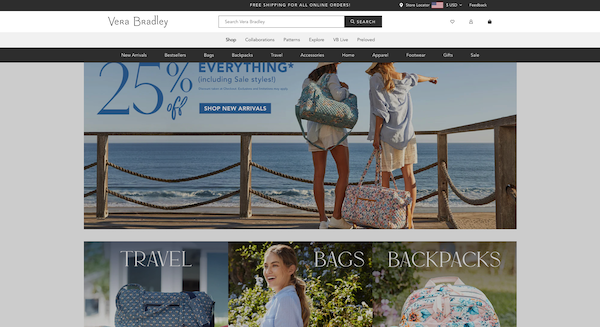
Image Source: Vera Bradley
Handbag brand Vera Bradley offers navigation that groups together similar products but also gives shoppers the chance to explore the entire product range at once.
Product Categories
It’s rare you’ll walk into a store that has random products grouped together. You’ll usually find the pet food next to the pet treats, just like you’d hope to find all women’s jeans in the same place. Your online product categories should follow a similar format. Grouping together similar products makes it easy for shoppers to find what they’re looking for while exposing them to more relevant products in your line.
Example of Product Categories: Spanx
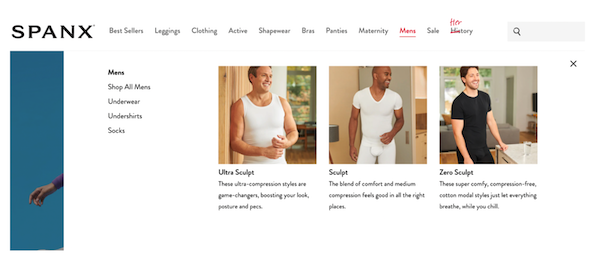
Image Source: Spanx
Shapewear and clothing brand Spanx groups together its men’s products in one place. It separates them by category (i.e., “underwear” and “socks”), but it also groups them by design (i.e., “ultra sculpt” and “zero sculpt”).
Visual Merchandising
Photos, images, videos, and other visual content help shoppers build a picture of your brand and products — something that’s critical online where they can’t touch or see a product in-person. Visual merchandising is made up of high-resolution images (usually with powerful zoom capabilities), 360-degree photos, videos, user-generated content (UGC), reviews, and content that tells a story. Think of it like a window display in a brick-and-mortar store.
Example of Visual Merchandising: Loaf
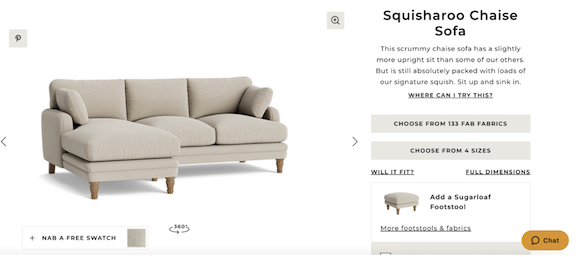
Image Source: Loaf
Sofa and home goods brand Loaf features 360-degree views of its products to help shoppers have more confidence when making high-ticket purchasing decisions.
Video Product Content
The biggest downside of online shopping is that consumers can’t experience a product before they buy. They can’t physically touch it, they can’t try it on, and they can’t decide whether they like the material or the color. Video content (and other forms of mixed media) help create an idea of a product by building it up in layers — it’s the closest shoppers will get to holding a product in their hands.
Example of Video Product Content: Ruggable
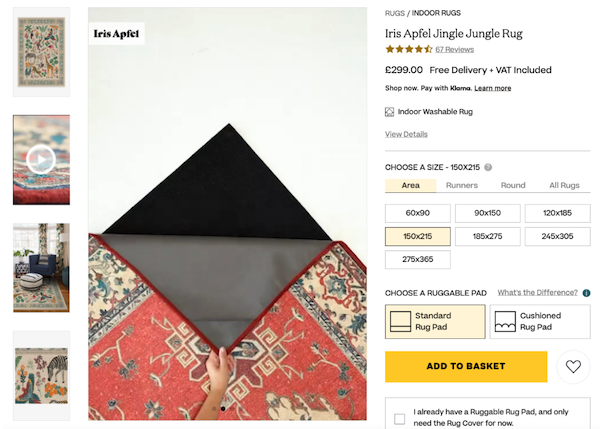
Image Source: Ruggable
Rug brand Ruggable uses video content to show close-ups of its products and highlight key features, like the non-slip undercoat and the intricate designs.
Enhanced Content
Enhanced content is PDP content that goes above and beyond. There’s certain information that’s mandatory on a product page, like a title, product description, and hero image, but enhanced content goes further with elements that aren’t strictly necessary but help create powerful shopping experiences.
Enhanced content generally sits below the fold and can include:
- Longer, customized product descriptions;
- Videos;
- Extensive image galleries;
- Feature tours;
- Comparison charts; and
- Downloadable material.
Basically, it’s anything that gives shoppers a more thorough understanding of your product and helps them decide if it’s a good fit. Salsify’s “2023 Shopper Research” report found that half of the respondents claimed the quality of images and product descriptions were two of the top three factors determining where they shop online. This shows how important it is to go above and beyond.
Example of Enhanced Content: Our Place
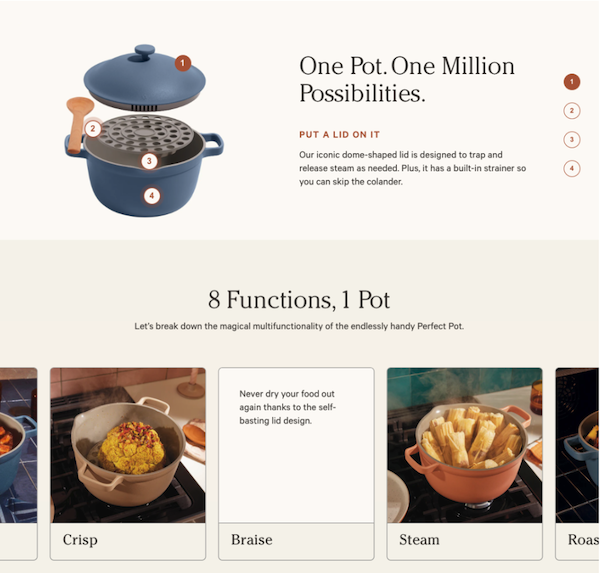
Image Source: Our Place
Home goods brand Our Place showcases a wealth of enhanced content on its PDP, including instruction manuals, recipe ideas, videos, and reviews.
Internal Search Capabilities
Brick-and-mortar shoppers can ask in-store sales associates where a product is — simple.
Online, it’s slightly different. Shoppers can’t see every SKU on the homepage like they might be able to in-store, so they often head straight to the search bar. In fact, 43% of shoppers on a retail site go directly to the search bar, per research and consulting firm Forrester. A good search function helps consumers find what they’re looking for and exposes them to your product catalog.
Example of Internal Search Capabilities: Oliver Bonas
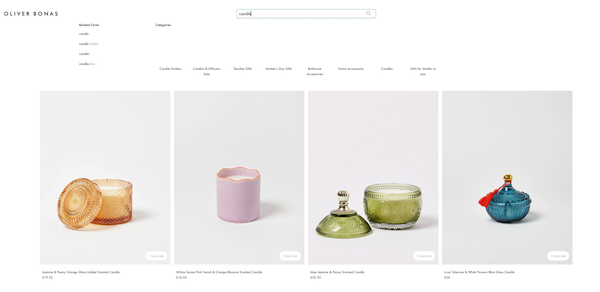
Image Source: Oliver Bonas
Shoppers can “choose their own adventure” when they use the fashion and lifestyle brand Oliver Bonas’ search function. They can go straight to product categories or buy direct from the search dropdown.
Product Setup and Activation
Getting your products online can be a mammoth task, especially if you’re populating marketplaces, retail endpoints, and your own website. Using a product information management (PIM) solution helps prepare large quantities of product data ready for syndication. This ultimately creates consistency and cohesiveness across the different platforms you use to sell your products.
Create Engaging Shopping Experiences With Visual Website Merchandising
According to customer service platform Tidio, 2.14 billion shoppers now buy products online. It’s not just the number of consumers choosing to shop online that’s increasing, but so is the frequency with which they shop online.
It’s no longer enough for brands to upload a few low-res images and a few lines of text and hope for the best. Instead, they need to practice website merchandising if they want to recreate the rich and powerful experiences shoppers have in-store.
Competition is fierce on the digital shelf — presenting the right content in a beautiful, organized way can make all the difference.






![15 Ways for Effectively Selling Electronics in 2023 [Top Websites]](https://thegateway.net.au/wp-content/uploads/2023/01/15-ways-for-effectively-selling-electronics-in-2023-top-websites-768x402.png)